Comprehensive Methodology for Assessing Structural Response to Probable Seismic Motions: Application to Guatemala City
Abstract
1. Introduction
2. Methodology
- (1)
- calculation of seismic hazard and definition of representative seismic scenarios;
- (2)
- analysis of local site effects through a seismic microzonation study; and
- (3)
- characterization of structural response to identify potential resonance effects.
3. Application in Guatemala City
3.1. Tectonic Framework
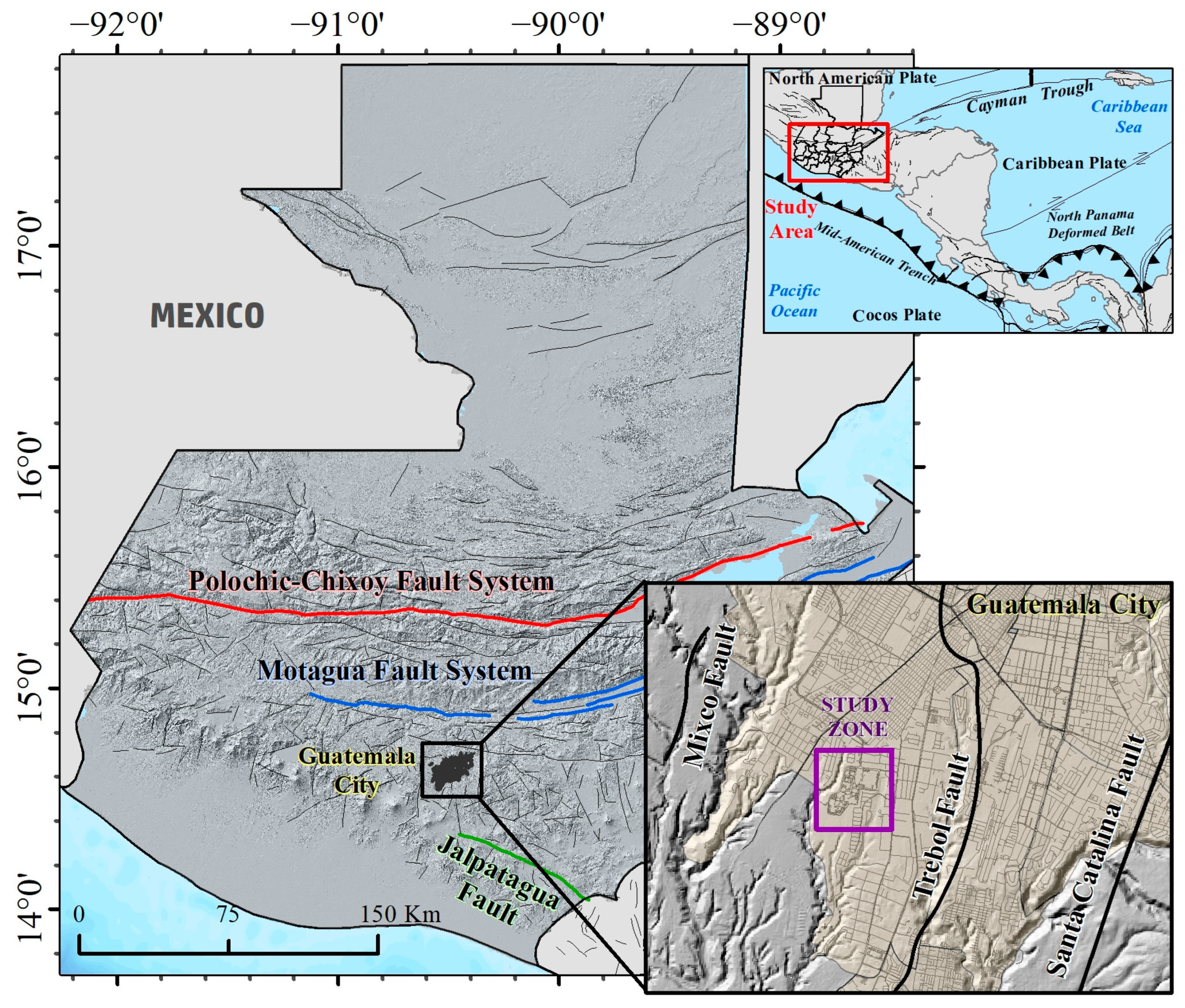
3.2. Seismic Hazard Assessment
3.3. Seismic Microzonation
3.4. Building Instrumental Analysis
3.5. Comparison of Response and Design Spectra
4. Discussion
5. Conclusions
- The PSHA study [31] identified the Motagua Fault Zone as the dominant source of seismic hazard for Guatemala City, with control earthquakes (M1,R1) = (6.5–7.0 Mw, 20–30 km) and (M2,R2) = (6.0–6.5 Mw, 20–30 km), for a return period of 475 years in PGA and Sa (0.5 s).
- Seismic microzonation revealed predominantly Type-C, Type-CD and Type-D soils according to the NSE 2.1 AGIES 2024 classification [42]. With Vs30 ranging from 210 to 640 m/s and fundamental frequencies below 1.0 Hz.
- Structural dynamic analysis of 32 high-occupancy buildings indicated fundamental frequencies between 1.25 and 5.65 Hz, confirming the absence of soil–structure resonance due to non-overlapping frequency ranges.
- The comparison between the site-specific response spectra and AGIES 2024 design spectra demonstrated that the latter adequately envelope the computed spectra for all soil–structure combinations, confirming their conservative character for the studied conditions. In light of the results of this study, the design spectrum of Guatemala’s AGIES NSE 2024 seismic code can be regarded as being conservative. Accordingly, they are fit to be used in the design of future buildings on the USAC campus, using the same construction systems as the buildings analyzed.
- The study integrates all key stages of seismic evaluation (PSHA, microzonation, site effects, structural response, and spectral comparison) into a coherent and replicable framework. However, it does not include a fully coupled soil–structure interaction (SSI) analysis, which would require numerical modeling of the soil–foundation–structure system. Therefore, our results should be interpreted as a first-order, screening-level assessment of SSI effects.
- Demonstrates real-world applicability through a comprehensive case study of 32 buildings at the USAC campus in Guatemala City; the methodology is scalable and cost-effective. The study is limited to one municipal site, but the method may be replicable to regions with different geotechnical or structural conditions.
- The spectral comparison between computed and design spectra effectively assesses the conservativeness of current building codes.
- Provides the first integrated seismic and structural response study for the USAC campus, establishing a reference for future retrofitting decisions and urban planning. As a weakness, it does not include nonlinear or time-history structural analyses, which would offer deeper insights into inelastic structural behavior. This would be the subject of a work on another scale and with greater detail.
- The study has a practical impact. Offers a rapid, low-cost, and replicable first-level screening tool suitable for resource-limited contexts
Supplementary Materials
Author Contributions
Funding
Data Availability Statement
Acknowledgments
Conflicts of Interest
References
- Bommer, J.J.; Abrahamson, N.A. Why Do Modern Probabilistic Seismic-Hazard Analyses Often Lead to Increased Hazard Estimates? Bull. Seismol. Soc. Am. 2006, 96, 1967–1977. [Google Scholar] [CrossRef]
- Powell, G.H. Displacement-Based Seismic Design of Structures. Earthq. Spectra 2008, 24, 555–557. [Google Scholar] [CrossRef]
- Cornell, A. Engineering Seismic Risk Analysis. Bull. Seismol. Soc. Am. 1968, 58, 1583–1606. [Google Scholar] [CrossRef]
- Esteva, L. Bases Para La Formulación de Decisiones de Diseño Sísmico. Ph.D. Thesis, Universidad Nacional de México, Ciudad de México, México, 1968. [Google Scholar]
- Ansal, A. Seismic Microzonation; Past, Present and Future. Bull. Earthq. Eng. 2025, 23, 3483–3506. [Google Scholar] [CrossRef]
- Loh, C.; Jean, W.; Penzien, J. Uniform-hazard Response Spectra—An Alternative Approach. Earthq. Eng. Struct. Dyn. 1994, 23, 433–445. [Google Scholar] [CrossRef]
- Bracchi, S.; Rota, M.; Penna, A.; Magenes, G. Consideration of Modelling Uncertainties in the Seismic Assessment of Masonry Buildings by Equivalent-Frame Approach. Bull. Earthq. Eng. 2015, 13, 3423–3448. [Google Scholar] [CrossRef]
- Gentile, R.; Galasso, C. Simplicity versus Accuracy Trade-off in Estimating Seismic Fragility of Existing Reinforced Concrete Buildings. Soil Dyn. Earthq. Eng. 2021, 144, 106678. [Google Scholar] [CrossRef]
- Cocco, G.; Spacone, E.; Brando, G. Seismic Vulnerability Assessment of Urban Areas Made of Adobe Buildings through Analytical and Numerical Methods: The Case Study of the Historical Center of Cusco (Peru). Int. J. Disaster Risk Reduct. 2024, 112, 104786. [Google Scholar] [CrossRef]
- Navas-Sánchez, L.; Jiménez-Martínez, M.; González-Rodrigo, B.; Hernández-Rubio, O.; Dávila-Migoya, L.D.; Orta-Rial, B.; Hidalgo-Leiva, D. A Methodology to Assess and Select Seismic Fragility Curves: Application to the Case of Costa Rica. Earthq. Spectra 2023, 39, 1380–1409. [Google Scholar] [CrossRef]
- Güllü, H.; Pala, M. On the Resonance Effect by Dynamic Soil-Structure Interaction: A Revelation Study. Nat. Hazards 2014, 72, 827–847. [Google Scholar] [CrossRef]
- Chávez-García, F.J.; Bard, P.-Y. Site Effects in Mexico City Eight Years after the September 1985 Michoacan Earthquakes. Soil Dyn. Earthq. Eng. 1994, 13, 229–247. [Google Scholar] [CrossRef]
- Kawase, H. The Cause of the Damage Belt in Kobe: “The Basin-Edge Effect” Constructive Interference of the Direct S-Wave with the Basin-Induced Diffracted/Rayleigh Waves. Seismol. Res. Lett. 1996, 67, 25–34. [Google Scholar] [CrossRef]
- Marzorati, S.; Ladina, C.; Falcucci, E.; Gori, S.; Saroli, M.; Ameri, G.; Galadini, F. Site Effects “on the Rock”: The Case of Castelvecchio Subequo (L’Aquila, Central Italy). Bull. Earthq. Eng. 2011, 9, 841–868. [Google Scholar] [CrossRef]
- Caserta, A.; Doumaz, F.; Costanzo, A.; Gervasi, A.; Thorossian, W.; Falcone, S.; La Piana, C.; Minasi, M.; Buongiorno, M.F. Assessing Soil-Structure Interaction during the 2016 Central Italy Seismic Sequence (Italy): Preliminary Results. Ann. Geophys. 2016, 59, 1–7. [Google Scholar] [CrossRef]
- Chopra, A.K. Dinámica de Estructuras; Cuarta Edición; Pearson: Naucalpan de Juárez, México, 2014; ISBN 978-607-32-2239-6. [Google Scholar]
- Gutenberg, B.; Richter, C.F. Frequency of Earthquakes in California. Bull. Seismol. Soc. Am. 1944, 34, 185–188. [Google Scholar] [CrossRef]
- Wolf, J.P. Dynamic Soil-Structure Interaction; Prentice-Hall: Englewood Cliffs, NJ, USA, 1985; ISBN 9780132215657. [Google Scholar]
- Gazetas, G. Formulas and Charts for Impedances of Surface and Embedded Foundations. J. Geotech. Eng. 1991, 117, 1363–1381. [Google Scholar] [CrossRef]
- Mylonakis, G.; Nikolaou, S.; Gazetas, G. Footings under Seismic Loading: Analysis and Design Issues with Emphasis on Bridge Foundations. Soil Dyn. Earthq. Eng. 2006, 26, 824–853. [Google Scholar] [CrossRef]
- Garnier, B.; Tikoff, B.; Flores, O.; Jicha, B.; DeMets, C.; Cosenza-Muralles, B.; Hernandez, W.; Greene, D. Deformation in Western Guatemala Associated with the NAFCA (North America-Central American Forearc-Caribbean) Triple Junction: Neotectonic Strain Localization Into the Guatemala City Graben. Tectonics 2022, 41, e2021TC006739. [Google Scholar] [CrossRef]
- Authemayou, C.; Brocard, G.; Teyssier, C.; Suski, B.; Cosenza, B.; Morán-Ical, S.; González-Véliz, C.W.; Aguilar-Hengstenberg, M.A.; Holliger, K. Quaternary Seismo-Tectonic Activity of the Polochic Fault, Guatemala. J. Geophys. Res. Solid Earth 2012, 117, 1–21. [Google Scholar] [CrossRef]
- Garnier, B.; Tikoff, B.; Flores, O.; Jicha, B.; DeMets, C.; Cosenza-Muralles, B.; Hernandez, D.; Marroquin, G.; Mixco, L.; Hernandez, W. An Integrated Structural and GPS Study of the Jalpatagua Fault, Southeastern Guatemala. Geosphere 2021, 17, 201–225. [Google Scholar] [CrossRef]
- Guzmán-Speziale, M.; Molina, E. Seismicity and Seismically Active Faulting of Guatemala: A Review. J. S. Am. Earth Sci. 2022, 115, 103740. [Google Scholar] [CrossRef]
- Pérez, C.L. Geological Structure of Guatemala City Valley Interpreted as a Pull Apart Basin. Rev. Geológica De América Cent. 2009, 41, 71–78. [Google Scholar] [CrossRef]
- Agate, M.; Caldareri, F.; Castillo, L.; Garcia, A.; Giunta, G.; Mixco, L.; Requena, J.; Rubi Tellez, C.; Ruiz, M.; Sulli, A.; et al. The Pattern of Brittle Deformation in Central America for an Assessment of the Seismo-Tectonic Framework. J. Maps 2024, 20, 2285479. [Google Scholar] [CrossRef]
- Styron, R.; García-Pelaez, J.; Pagani, M. CCAF-DB: The Caribbean and Central American Active Fault Database. Nat. Hazards Earth Syst. Sci. 2020, 20, 831–857. [Google Scholar] [CrossRef]
- Pilz, M.; Parolai, S.; Leyton, F.; Campos, J.; Zschau, J. A Comparison of Site Response Techniques Using Earthquake Data and Ambient Seismic Noise Analysis in the Large Urban Areas of Santiago de Chile. Geophys. J. Int. 2009, 178, 713–728. [Google Scholar] [CrossRef]
- Moisidi, M.; Vallianatos, F.; Gallipoli, M.R. Assessing the Main Frequencies of Modern and Historical Buildings Using Ambient Noise Recordings: Case Studies in the Historical Cities of Crete (Greece). Heritage 2018, 1, 171–188. [Google Scholar] [CrossRef]
- Gamboa-Canté, C.; Arroyo-Solórzano, M.; Benito, B.; Aguilar, J.; Arroyo, I.G.; Camacho-Astigarrabia, E.; Castro, D.; Flores, O.; Linkimer, L.; Marroquin, M.G.; et al. Seismicity in Central America (1520–2020) and Earthquake Catalog Compilation for Seismic Hazard Assessments. Bull. Earthq. Eng. 2024, 22, 7201–7234. [Google Scholar] [CrossRef]
- Gamboa-Canté, C.; Arroyo-Solórzano, M.; Rivas-Medina, A.; Benito, M.B. Overview of Seismic Hazard Studies in Central America: A Comparative Analysis of Results. J. S. Am. Earth Sci. 2025, 164, 105630. [Google Scholar] [CrossRef]
- Alvarado, G.E.; Benito, B.; Staller, A.; Climent, Á.; Camacho, E.; Rojas, W.; Marroquín, G.; Molina, E.; Talavera, J.E.; Martínez-Cuevas, S.; et al. The New Central American Seismic Hazard Zonation: Mutual Consensus Based on up to Day Seismotectonic Framework. Tectonophysics 2017, 721, 462–476. [Google Scholar] [CrossRef]
- Arroyo-Solórzano, M.; Belén Benito, M.; Alvarado, G.E.; Climent, A. Empirical Earthquake Source Scaling Relations for Maximum Magnitudes Estimations in Central America. Bull. Seismol. Soc. Am. 2024, 114, 1539–1567. [Google Scholar] [CrossRef]
- Gamboa-Canté, C.; Arroyo-Solórzano, M.; Rivas-Medina, A.; Benito, B. Sensitivity Analysis on the Impact of Input Parameters on Seismic Hazard Results: A Case Study of Central America. Geoscience 2025, 15, 4. [Google Scholar] [CrossRef]
- Xu, R.; Wang, L. The Horizontal-to-Vertical Spectral Ratio and Its Applications. EURASIP J. Adv. Signal Process. 2021, 2021, 75. [Google Scholar] [CrossRef]
- Park, C.B.; Miller, R.D.; Xia, J. Multichannel Analysis of Surface Waves. Geophysics 1999, 64, 800–808. [Google Scholar] [CrossRef]
- Haghshenas, E.; Bard, P.Y.; Theodulidis, N.; Atakan, K.; Cara, F.; Cornou, C.; Cultrera, G.; Di Giulio, G.; Dimitriu, P.; Fäh, D.; et al. Empirical Evaluation of Microtremor H/V Spectral Ratio. Bull. Earthq. Eng. 2008, 6, 75–108. [Google Scholar] [CrossRef]
- Castellaro, S.; Mulargia, F.; Bianconi, L. Passive Seismic Stratigraphy: A New Efficient, Fast and Economic Technique. Geol. Tec. Ambient. 2005, 3, 76–102. [Google Scholar]
- Oberst, U. The Fast Fourier Transform. SIAM J. Control Optim. 2007, 46, 496–540. [Google Scholar] [CrossRef]
- Molnar, S.; Cassidy, J.F.; Castellaro, S.; Cornou, C.; Crow, H.; Hunter, J.A.; Matsushima, S.; Sánchez-Sesma, F.J.; Yong, A. Application of Microtremor Horizontal-to-Vertical Spectral Ratio (MHVSR) Analysis for Site Characterization: State of the Art. Surv. Geophys. 2018, 39, 613–631. [Google Scholar] [CrossRef]
- Castellaro, S.; Mulargia, F. VS30 Estimates Using Constrained H/V Measurements. Bull. Seismol. Soc. Am. 2009, 99, 761–773. [Google Scholar] [CrossRef]
- Paiz, B.; Callejas Benítez, F.; Semrau Lago, R.; Pérez Zarco, A.; Valdéz Arandi, H.; De León, W.; Rubio, Á.; Leiva, L. NSE 2.1—Estudios Geotécnicos; Asociación Guatemalteca de Ingeniería Estructural y Sísmica, AGIES: Ciudad de Guatemala, Guatemala, 2024. [Google Scholar]
- Castellaro, S. The Complementarity of H/V and Dispersion Curves. Geophysics 2016, 81, T323–T338. [Google Scholar] [CrossRef]
- Trifunac, M.D. Comparisons between Ambient and Forced Vibration Experiments. Earthq. Eng. Struct. Dyn. 1972, 1, 133–150. [Google Scholar] [CrossRef]
- Castellaro, S.; Mulargia, F. How Far from a Building Does the Ground-Motion Free-Field Start? The Cases of Three Famous Towers and a Modern Building. Bull. Seismol. Soc. Am. 2010, 100, 2080–2094. [Google Scholar] [CrossRef]
- Castellaro, S.; Padrón, L.A.; Mulgaria, F. The Different Response of Apparently Identical Structures: A Far-Field Lesson from the Mirandola 20 May 2012 Earthquake. Bull. Earthq. Eng. 2013, 12, 2481–2493. [Google Scholar]
- Castellaro, S.; Perricone, L.; Bartolomei, M.; Isani, S. Dynamic Characterization of the Eiffel Tower. Eng. Struct. 2016, 126, 628–640. [Google Scholar] [CrossRef]
- Prati, D.; Badini, L.; Mochi, G.; Castellaro, S.; Ferrante, A. Passive Single-Station Techniques Applied for Dynamic Characterization of Reinforced Concrete Buildings. Riv. Tema 2020, 6, 18–28. [Google Scholar] [CrossRef]
- Pan, Y.; Ventura, C.E.; Xiong, H.; Zhang, F.-L. Model Updating and Seismic Response of a Super Tall Building in Shanghai. Comput. Struct. 2020, 239, 106285. [Google Scholar] [CrossRef]
- Li, J.; Bao, T.; Ventura, C.E. A Robust Methodology for Output-Only Modal Identification of Civil Engineering Structures. Eng. Struct. 2022, 270, 114764. [Google Scholar] [CrossRef]
- Nogoshi, M.; Igarashi, T. On the Amplitude Characteristics of Microtremor (Part 2). J. Seismol. Soc. Jpn. 1971, 24, 26–40. [Google Scholar] [CrossRef]
- Lermo, J.; Chávez-García, F.J. Site Effect Evaluation Using Spectral Ratios with Only One Station. Bull. Seismol. Soc. Am. 1993, 83, 1574–1594. [Google Scholar] [CrossRef]
- Instituto Nacional de Sismologia; Vulcanologia; Meteorologia e Hidrologia (INSIVUMEH) Red Sismologica Nacional [Data Set]. International Federation of Digital Seismograph Networks. 1976. Available online: https://www.fdsn.org/networks/detail/GI/ (accessed on 15 August 2025).
- Hashash, Y.M.A.; Musgrove, M.I.; Harmon, J.A.; Ilhan, O.; Xing, G.; Numanoglu, O.; Groholski, D.R.; Phillips, C.A.; Park, D. DeepSoil 7.0: User Manual; University of Illinois: Champaign, IL, USA, 2020. [Google Scholar]
- Paiz, B.; Cruz, D.; Monzón Despang, H.; Rodas, J.A.; Chang Campang, R.; Flores, O.; Gonzáles, W.; Ligorría, J.P. NSE 2—Demandas Estructurales Y Condiciones De Sitio; Asociación Guatemalteca de Ingeniería Estructural y Sísmica, AGIES: Ciudad de Guatemala, Guatemala, 2024. [Google Scholar]
- Paiz, B.; Cruz, D.; Monzón, H.; Rodas, J.A.; Chang Campang, R.; Flores, O.; Gonzáles, W.; Ligorría, J.P. NSE 3—Diseño Estructural De Edificaciones; Asociación Guatemalteca de Ingeniería Estructural y Sísmica, AGIES: Ciudad de Guatemala, Guatemala, 2024. [Google Scholar]
- Kanai, K. Relation between the Nature of Surface Layer and the Amplitudes of Earthquake Motions. Bull. Earthq. Res. Inst. 1952, 30, 31–37. [Google Scholar]
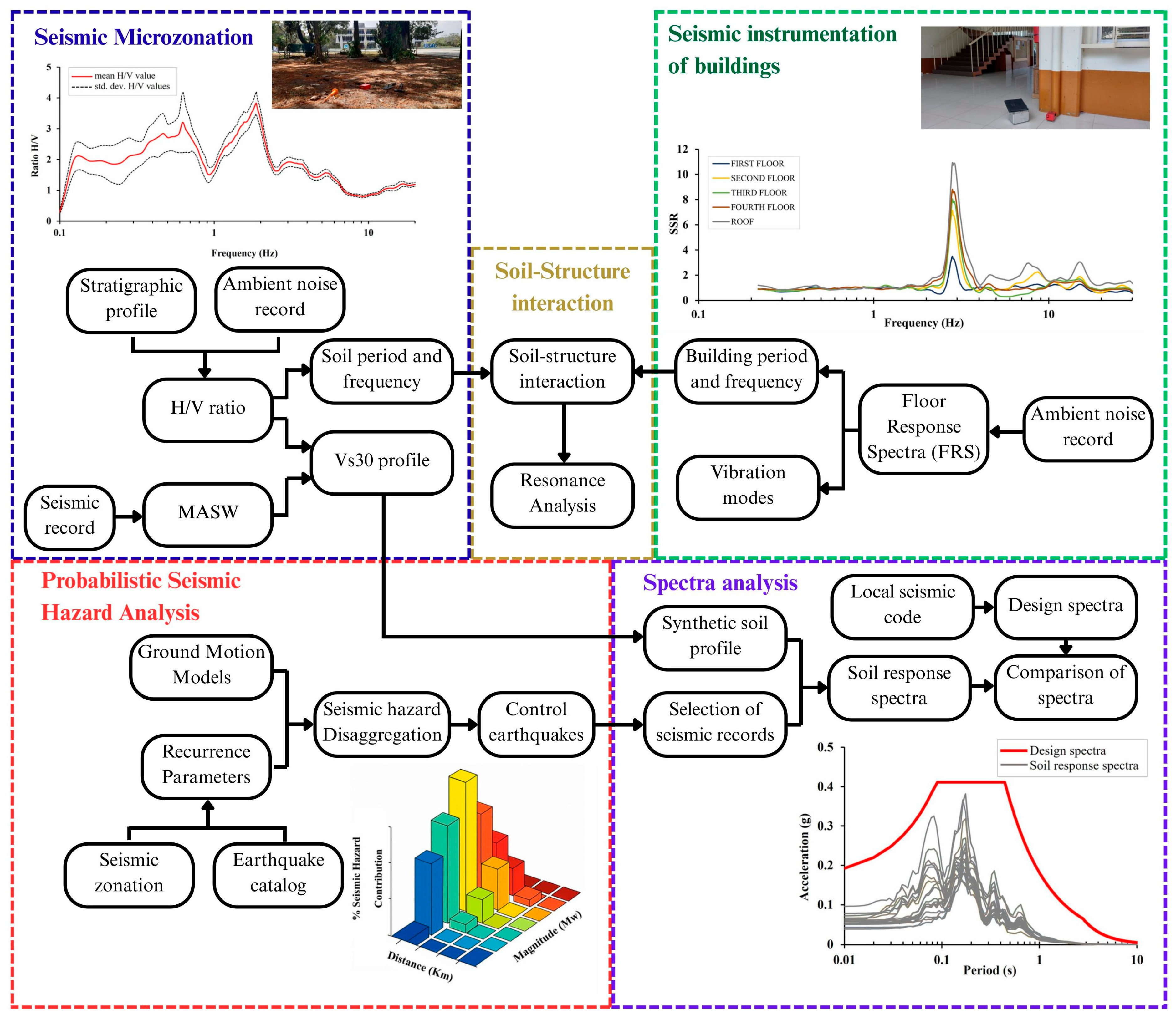
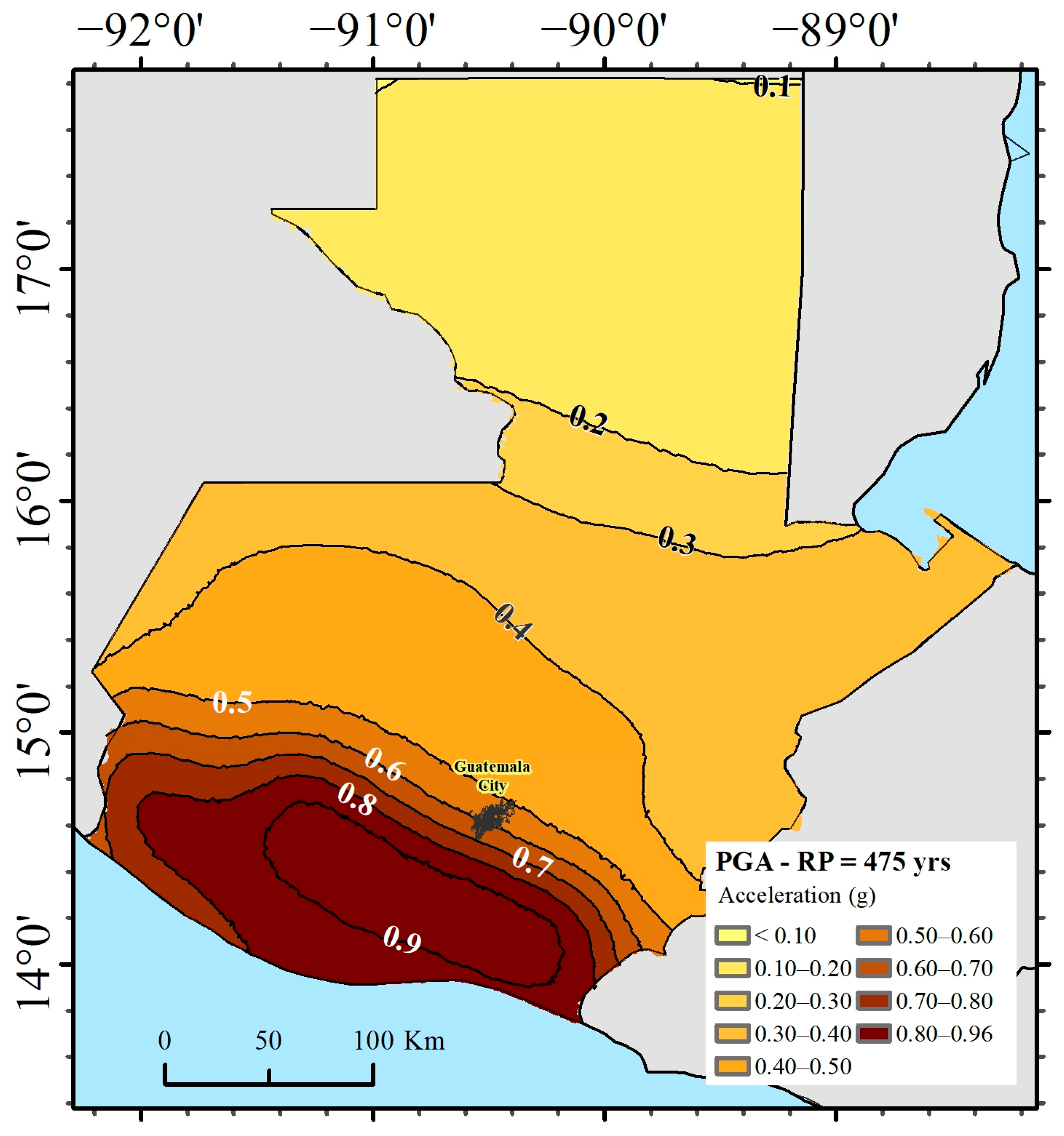
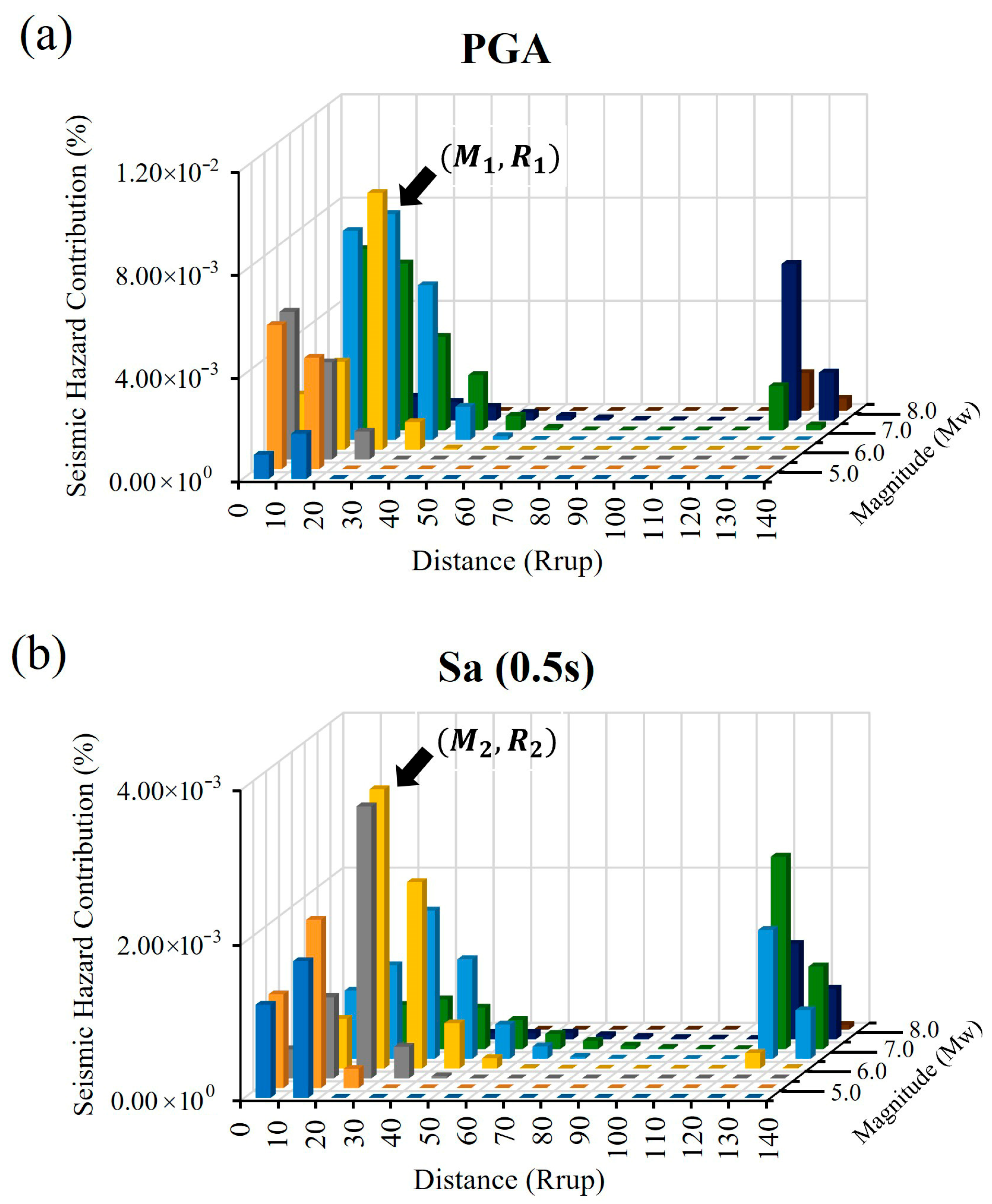
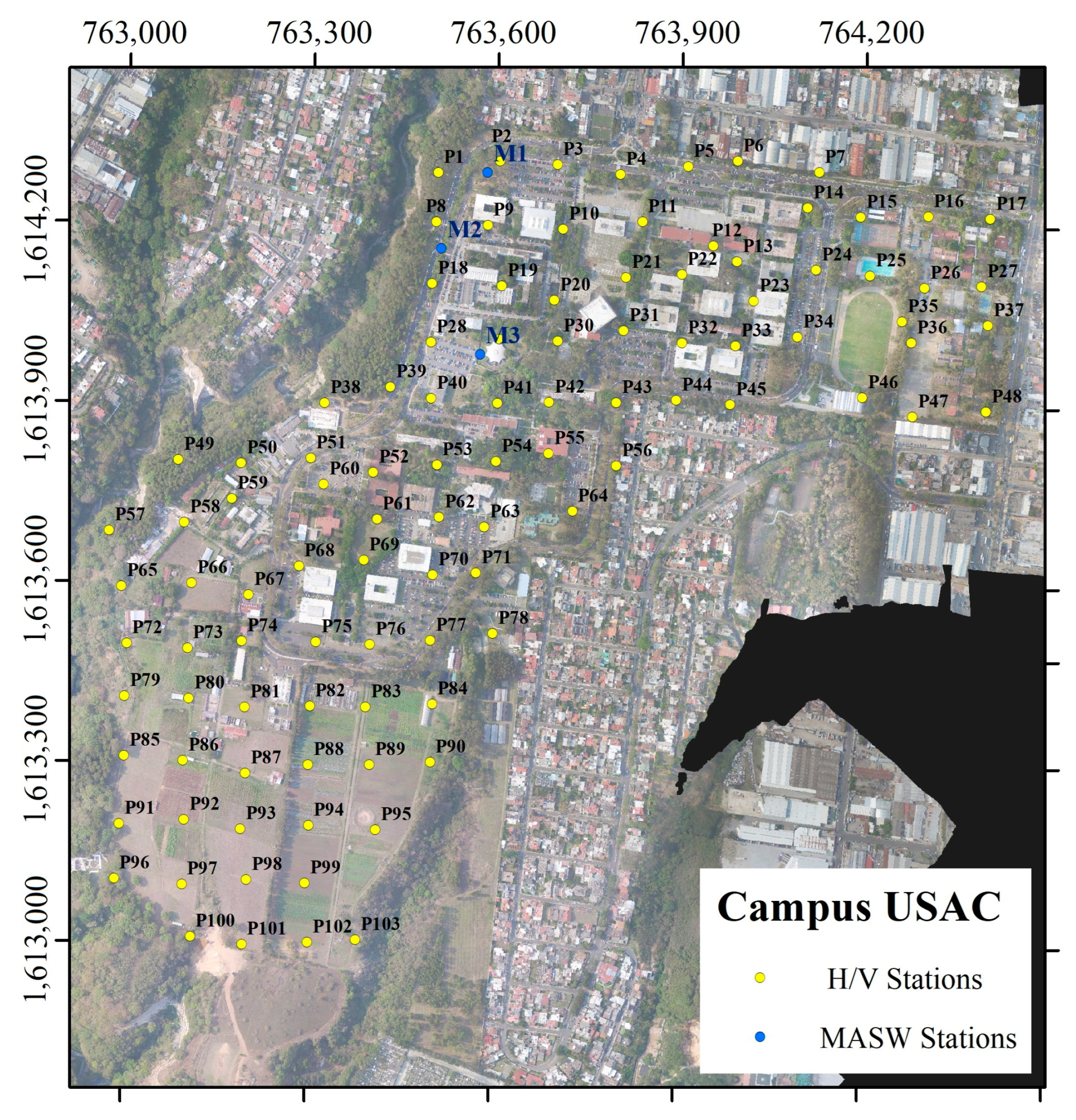
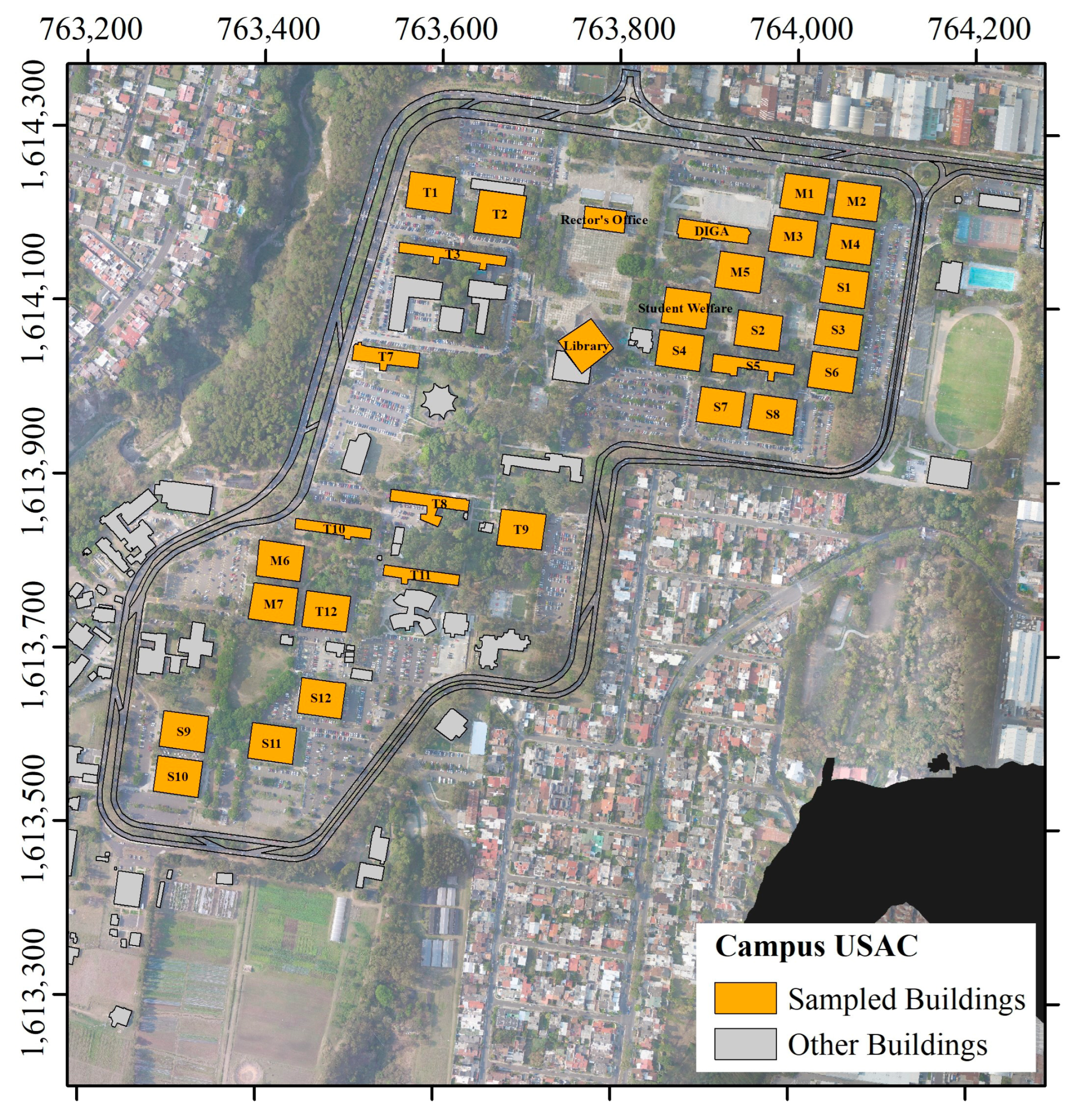
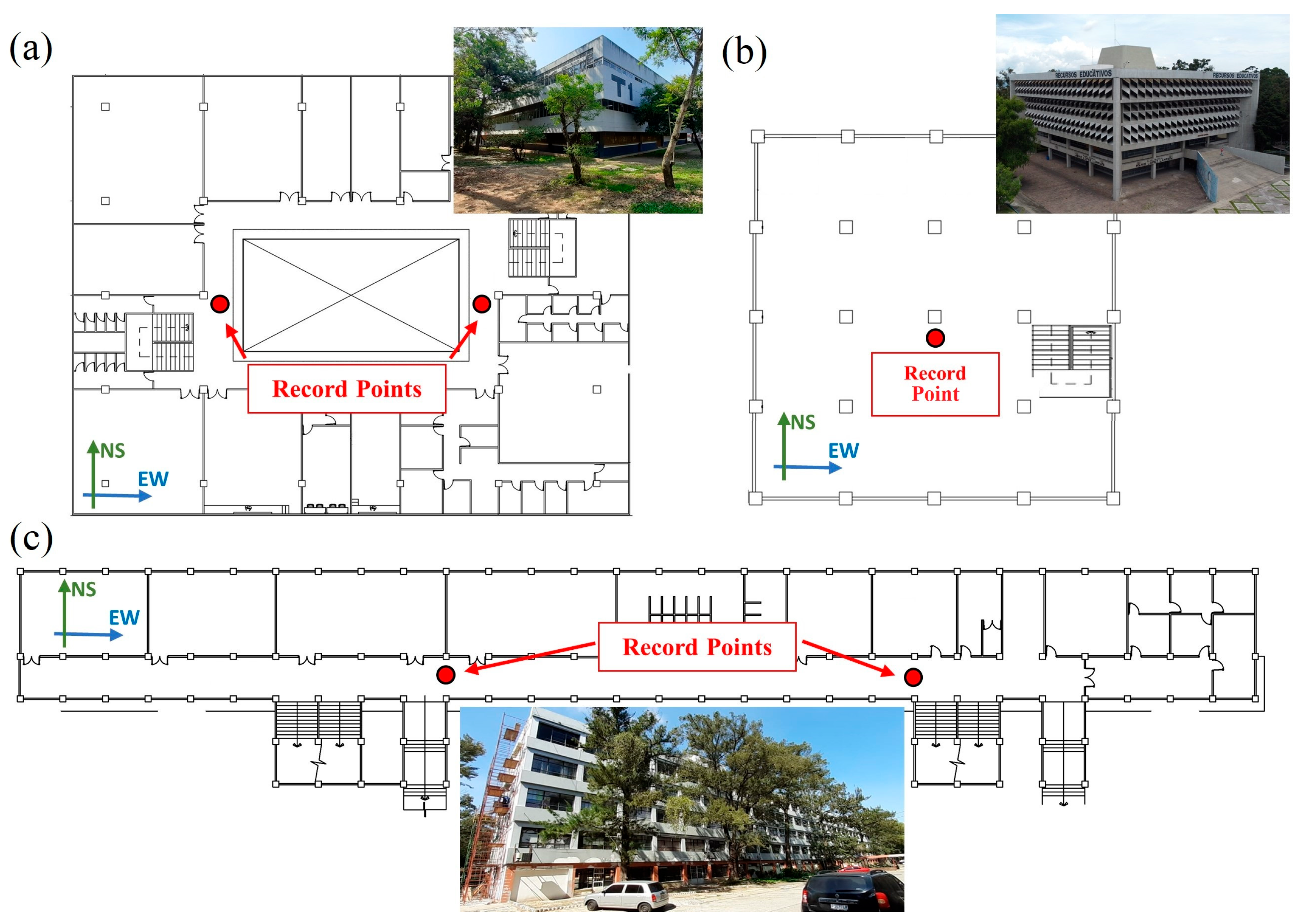

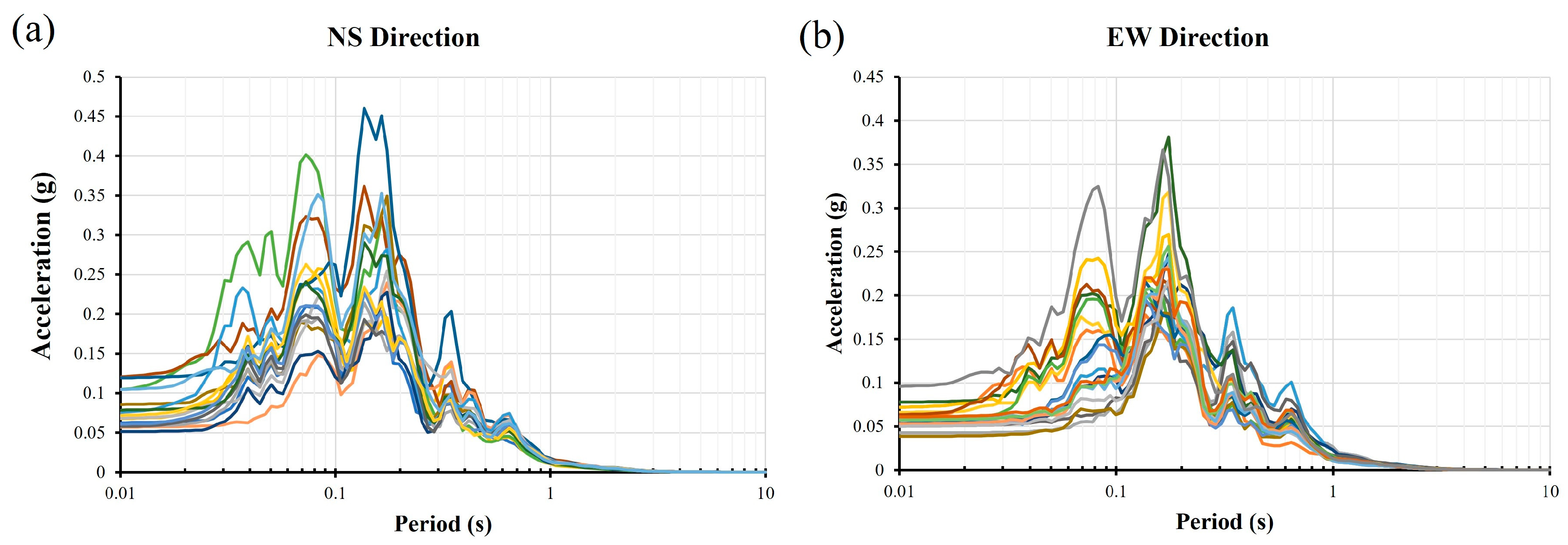


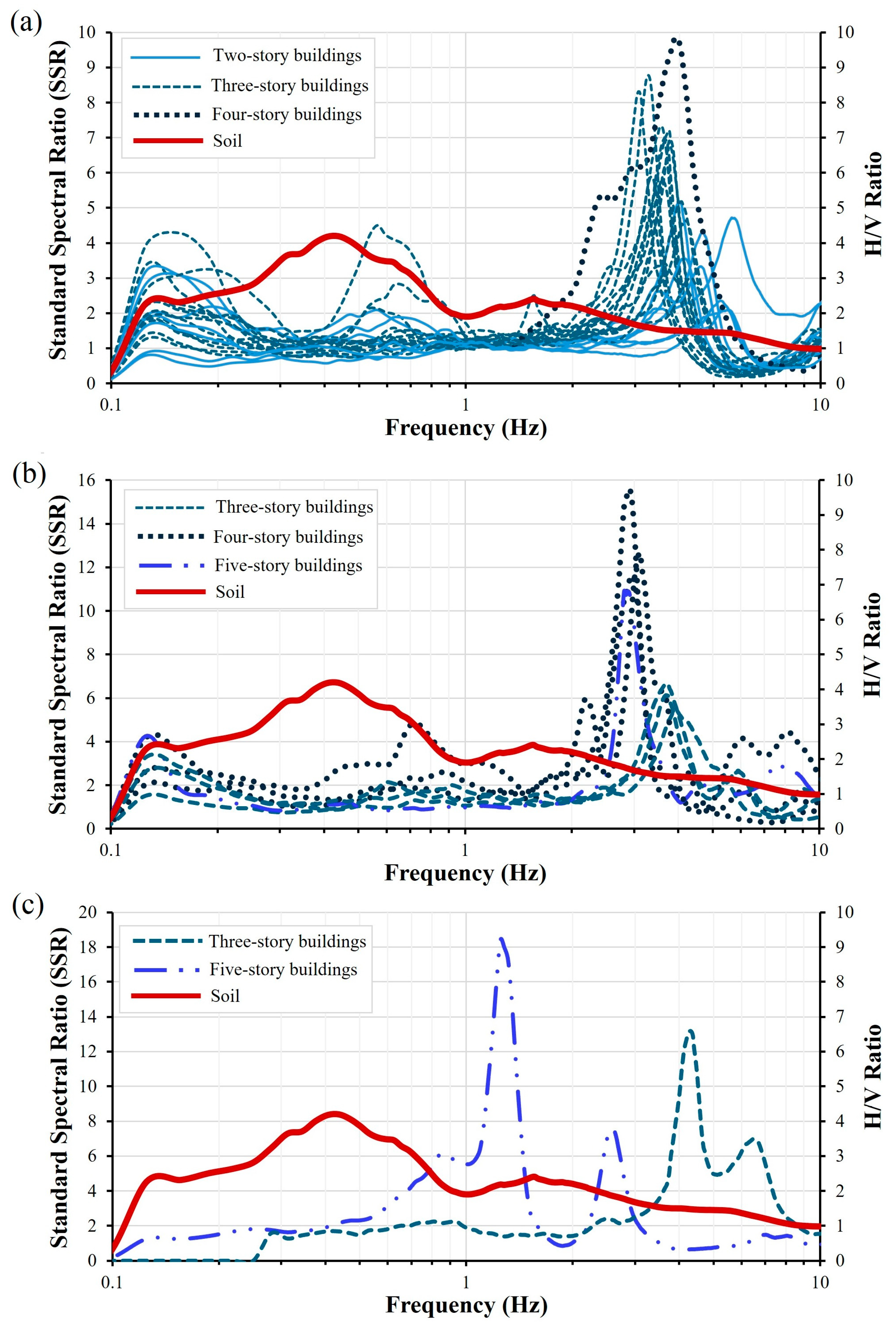


| Place | Date | Magnitude Mw | Intensity MM |
|---|---|---|---|
| Alta Verapaz | 22 July 1816 | 7.5 | VII |
| Quetzaltenango | 18 April 1902 | 7.5 | VII |
| Cuilapa | 8 March 1913 | 5 | V |
| Guatemala City | 25 December 1917 | 5.6 | VII–IX |
| Guatemala City | 4 January 1918 | 6.0 | VI |
| Tecpán, Chimaltenango | 6 August 1942 | 7.9 | IX |
| Ixcán, Quiché | 20 February 1959 | 6.0 | VI |
| Guatemala City | 4 February 1976 | 7.5 | X |
| Uspantán | 11 October 1985 | 5.0 | VII |
| San Vicente Pacaya | 3 November 1988 | 6.0 | VI |
| Pochuta | 9 November 1991 | 5.3 | VII |
| San Marcos | 10 September 1993 | 7.2 | VIII |
| San Miguel Tucurú, Alta Verapaz | 19 December 1995 | 5.3 | IV |
| Santo Domingo, Suchitepéquez | 10 January 1998 | 6.6 | VII |
| Patzún, Chimaltenango | 3 May 2009 | 6.2 | VI |
| San Mateo Ixtatán, San Marcos | 23 February 2010 | 5.6 | VII |
| Champerico, Retalhuleu | 7 November 2012 | 7.4 | VII |
| San Pablo, San Marcos | 6 November 2017 | 6.6 | VII |
| Area | No. | Building Name | Description | Building Shape | No. of Floors | FREQUENCY (Hz) | |
|---|---|---|---|---|---|---|---|
| NS | EW | ||||||
| Administrative and essential use | 1 | RECTORY | Rector’s Office | Rectangle | 4 | 2.90 | 2.65 |
| 2 | DIGA | General Directorate of Administration | Rectangle | 4 | 2.95 | 3.70 | |
| 3 | LIBRARY | USAC Library | Square | 5 | 1.25 | 1.45 | |
| 4 | STUDENT WELL BEING | Student Well-Being | Courtyard-type (covered roof) | 3 | 3.70 | 3.55 | |
| Health Sciences | 5 | M1 | Faculty of Dentistry | Courtyard-type | 2 | 5.35 | 4.90 |
| 6 | M3 | Faculty of Dentistry | Courtyard-type | 3 | 3.20 | 3.10 | |
| 7 | M4 | Faculty of Dentistry | Courtyard-type | 3 | 3.60 | 3.35 | |
| 8 | M6 | Faculty of Veterinary Medicine and Animal Science | Courtyard-type | 2 | 4.00 | 3.40 | |
| 9 | M7 | Faculty of Veterinary Medicine and Animal Science | Courtyard-type | 3 | 3.30 | 2.85 | |
| Political Sciences | 10 | M2 | School of Communication Sciences and Linguistic Sciences | Courtyard-type | 2 | 5.50 | 4.65 |
| 11 | M5 | School of Political Science | Courtyard-type | 2 | 5.65 | 4.95 | |
| 12 | S1 | School of History and Social Work | Courtyard-type | 3 | 3.55 | 3.40 | |
| 13 | S2 | Faculty of Legal and Social Sciences | Courtyard-type (covered roof) | 3 | 3.65 | 3.40 | |
| 14 | S3 | Faculty of Economics | Courtyard-type (covered roof) | 3 | 3.55 | 3.40 | |
| 15 | S4 | Faculty of Humanities | Courtyard-type (covered roof) | 2 | 4.15 | 4.50 | |
| 16 | S5 | Faculty of Legal and Social Sciences | Rectangle | 3 | 3.90 | 4.90 | |
| 17 | S6 | Faculty of Economic Sciences | Courtyard-type | 3 | 3.25 | 2.85 | |
| 18 | S7 | Faculty of Legal and Social Sciences | Courtyard-type | 2 | 4.65 | 4.10 | |
| 19 | S8 | Faculty of Economic Sciences | Courtyard-type (covered roof) | 2 | 4.60 | 4.05 | |
| 20 | S9 | Faculty of Economic Sciences | Courtyard-type (covered roof) | 3 | 3.75 | 3.65 | |
| 21 | S10 | Faculty of Economic Sciences | Courtyard-type (covered roof) | 3 | 4.00 | 3.60 | |
| 22 | S12 | Faculty of Legal and Social Sciences | Courtyard-type (covered roof) | 4 | 3.80 | 3.70 | |
| Science and Technology | 23 | S11 | Faculty of Engineering | Courtyard-type | 3 | 4.15 | 3.90 |
| 24 | T1 | Faculty of Engineering/Architecture | Courtyard-type | 3 | 4.65 | 4.40 | |
| 25 | T2 | Faculty of Architecture | Courtyard-type (covered roof) | 3 | 3.60 | 4.20 | |
| 26 | T3 | Faculty of Engineering | Rectangle | 5 | 2.80 | 3.70 | |
| 27 | T7 | Faculty of Engineering | Square | 3 | 4.25 | 5.25 | |
| 28 | T8 | Faculty of Agronomy | Rectangle | 4 | 3.10 | 2.15 | |
| 29 | T9 | Faculty of Agronomy | Courtyard-type | 3 | 3.05 | 2.90 | |
| 30 | T10 | Faculty of Chemical Sciences and Pharmacy | Rectangle | 3 | 3.70 | 5.30 | |
| 31 | T11 | Faculty of Chemical Sciences and Pharmacy | Rectangle | 3 | 3.70 | 5.50 | |
| 32 | T12 | Faculty of Chemical Sciences and Pharmacy | Courtyard-type | 2 | 5.25 | 5.30 | |
Disclaimer/Publisher’s Note: The statements, opinions and data contained in all publications are solely those of the individual author(s) and contributor(s) and not of MDPI and/or the editor(s). MDPI and/or the editor(s) disclaim responsibility for any injury to people or property resulting from any ideas, methods, instructions or products referred to in the content. |
© 2025 by the authors. Licensee MDPI, Basel, Switzerland. This article is an open access article distributed under the terms and conditions of the Creative Commons Attribution (CC BY) license (https://creativecommons.org/licenses/by/4.0/).
Share and Cite
Gamboa-Canté, C.; Benito, M.B.; Flores, O.; Pérez-Arias, C. Comprehensive Methodology for Assessing Structural Response to Probable Seismic Motions: Application to Guatemala City. Geosciences 2025, 15, 427. https://doi.org/10.3390/geosciences15110427
Gamboa-Canté C, Benito MB, Flores O, Pérez-Arias C. Comprehensive Methodology for Assessing Structural Response to Probable Seismic Motions: Application to Guatemala City. Geosciences. 2025; 15(11):427. https://doi.org/10.3390/geosciences15110427
Chicago/Turabian StyleGamboa-Canté, Carlos, María Belén Benito, Omar Flores, and Carlos Pérez-Arias. 2025. "Comprehensive Methodology for Assessing Structural Response to Probable Seismic Motions: Application to Guatemala City" Geosciences 15, no. 11: 427. https://doi.org/10.3390/geosciences15110427
APA StyleGamboa-Canté, C., Benito, M. B., Flores, O., & Pérez-Arias, C. (2025). Comprehensive Methodology for Assessing Structural Response to Probable Seismic Motions: Application to Guatemala City. Geosciences, 15(11), 427. https://doi.org/10.3390/geosciences15110427







